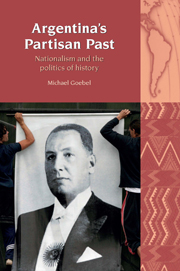Book contents
- Frontmatter
- Contents
- Acknowledgements
- List of acronyms and abbreviations
- Introduction
- 1 Argentina's two pantheons: from mitrismo to revisionism
- 2 Between co-optation and opposition: Peronism, nationalism and the politics of history, 1943–55
- 3 The deepening polarisation: the proscription of Peronism and its politics of history, 1955–66
- 4 The apogee of revisionism: nationalism, political violence and the politics of history, 1966–76
- 5 New narratives for a new era? Shifts, decline and resurgence of nationalist constructions of the past since 1976
- Conclusion
- Glossary
- Bibliography
- Index
4 - The apogee of revisionism: nationalism, political violence and the politics of history, 1966–76
- Frontmatter
- Contents
- Acknowledgements
- List of acronyms and abbreviations
- Introduction
- 1 Argentina's two pantheons: from mitrismo to revisionism
- 2 Between co-optation and opposition: Peronism, nationalism and the politics of history, 1943–55
- 3 The deepening polarisation: the proscription of Peronism and its politics of history, 1955–66
- 4 The apogee of revisionism: nationalism, political violence and the politics of history, 1966–76
- 5 New narratives for a new era? Shifts, decline and resurgence of nationalist constructions of the past since 1976
- Conclusion
- Glossary
- Bibliography
- Index
Summary
Introduction
The most evident development in Argentine history during the ten years following the coup d'état of June 1966 was the rise in political violence, which found an early catalyst in the student-worker riots of Córdoba in 1969 (the cordobazo). These gave momentum to the growth of mostly urban guerrilla groups, which pushed the military regime into allowing the return of Perón in 1973, in the misplaced hope that his leadership would pacify the country. Instead, the cycle of violence deepened, was exacerbated by Perón's death in July 1974 and eventually culminated in the state terror of the military dictatorship of 1976–83. The origins of political violence have, unsurprisingly, been the overriding concern of scholars of this period. In recent years, interest in the armed struggle of various left-leaning guerrilla groups, in particular the Peronist Montoneros and the Marxist Ejército Revolucionario del Pueblo (ERP), has even led to the emergence of specialised journals such as Políticas de la Memoria or Lucha Armada en la Argentina. Most historians would agree that arguments about national identity and nationalism were idely employed to legitimise violence, but again, this issue has not often been addressed in its own right. One reason for this is that ‘nationalism’, pervading so many different actors in various ways, is rather difficult to pin down as an independent variable or as a definable political agent. It is equally problematic to attribute the rise in political violence to any particular ‘nationalist ideology’.
- Type
- Chapter
- Information
- Argentina's Partisan PastNationalism and the Politics of History, pp. 145 - 180Publisher: Liverpool University PressPrint publication year: 2011

